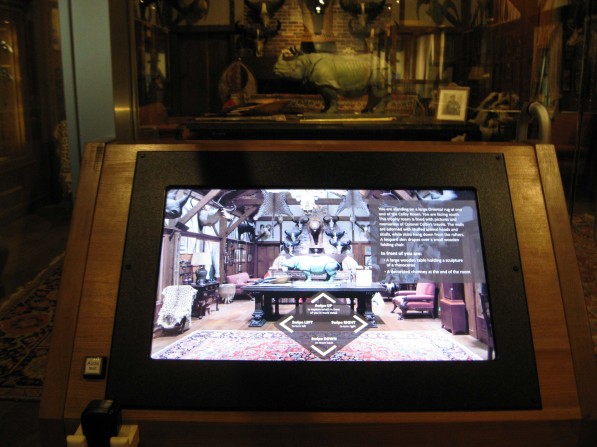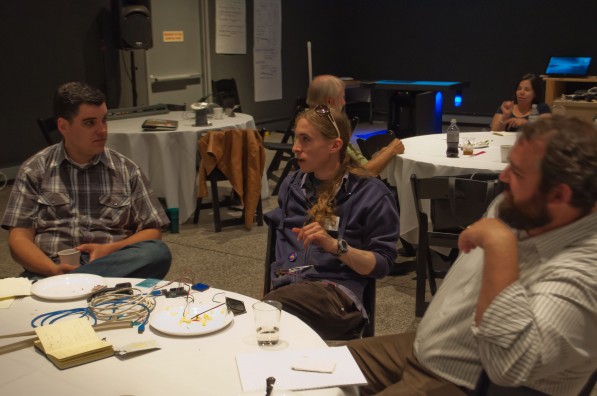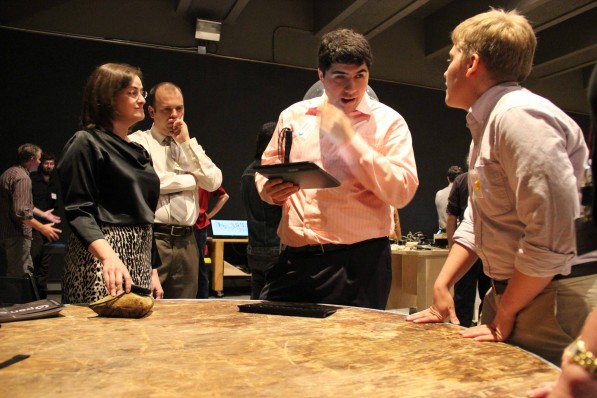CMME Workshop Discussion: Applying Universal Design to Museum Experiences
The Creating Museum Media for Everyone (CMME) workshop brought experts from many different fields together to consider how to create accessible digital interactives for museums. Much of the week-long CMME workshop was spent creating prototypes for digital interactives that focused on data manipulation. In addition, workshop participants had one discussion about other typical museum experiences that are facilitated through digital interactives and how they might be made more inclusive to all visitors.
The three types of digital interactive-based museum offerings that CMME workshop participants discussed were:
- exploring artifact-based collections,
- learning about current science and technology through an updating newsfeed, and
- taking part in design-based activities.
Outlined below is an overview of the questions and ideas that arose in the discussions around making these experiences accessible to all visitors.
Exploring artifact-based collections
During the CMME workshop, participants discussed how computer interactives can be used to help offer interpretation of artifacts that are presented in a museum’s galleries. As can be seen in the photo below, the Museum of Science has incorporated digital interpretation in some of their exhibitions such as the Colby Room to allow visitors to explore artifacts that would otherwise be inaccessible.

Photo of a digital interactive that allows visitors to explore artifacts in the Colby Room at the Museum of Science, Boston
However, at the CMME workshop participants discussed how making artifacts accessible requires more than just offering the interpretation in multiple formats. Some of the main questions and ideas that came up when thinking about how computer interactives could help visitors explore artifact-based collections are listed below.
What do you need to keep in mind about the design of the learning experience?
- Consider what will be most meaningful for your visitors when deciding what to display. There may be pros and cons to displaying detailed information about each artifact.
- Include tactile or haptic versions of the artifacts to increase opportunities for engagement. Teaching collections may be one way to allow visitors to handle artifacts.
- Provide additional interpretive materials such as labels with pertinent information or descriptive audio messages so that more visitors can better understand the collections or messages you are trying to convey.
- Think about how computer-based interactives can provide further opportunities for learning and engagement. Interactives could link to a digital database or allow visitors to add their own knowledge about an artifact to the display.
- Consider ways to simplify information and provide organization and structure so that visitors with a range of abilities can access the information. For example, offer a general overview of the digital interactive’s content before options for drilling deeper.
- Create compelling stories that allow more people to engage with the exhibit. Use provocative pairing of objects to help visitors connect with the display and the overall exhibit message.

Photo of professionals brainstorming at the CMME workshop
Learning about current science and technology through an updating news feed
Another type of digital media experience that some museums offer is an updating “news feed” of information. These communication channels are providing new ways to interact with visitors and non-visitors alike. For example, science centers may be posting Twitter-type updates or links about new scientific discoveries to their website. At the CMME workshop, participants discussed some of the following questions when considering the creation and accessibility of these increasingly popular digital museum experiences.
What is the purpose of your news feed?
- Articulate what your museum is trying to accomplish in order to help potential followers have a better understanding of the type of information that will be included.
- Are you trying to digitally engage people after their on-site visits are over?
- Do you want to show that scientific research is occurring in real time?
- Do you feel that access to current information will help inform the public’s decision-making?
What types of information are people expecting to receive from the museum on an updating basis?
- People don’t necessarily look to museums as sources for breaking news.
- Highlighting connections between news stories and the institution’s mission, exhibits, or collections may help people better understand the museum’s relevance.
Who is curating the posted information and what is the timeframe of breaking news?
- Where does this digital information come from? Quality matters.
- Who posts new information? Museums are in a unique position to add additional context or background information to a story by drawing from their own institutional research or exhibits.
- When will new posts be uploaded? Reliability is important.
Is the news feed universally designed and accessible?
- Museums must create accessible ways for people to navigate through the available information and perceive what is on the news feed.
- For visitors who are blind or have low vision, is the news feed screen-reader compatible? Are there audible options for learning about updates?
- For some visitors on the autism spectrum the news feed should not be too visually overwhelming.
Will people be able to contribute to the conversation?
- Allowing people to add their own opinions and share information might further the conversation and deliver a more engaging experience for visitors.
- It is necessary to provide feedback opportunities that are accessible to a range of users.

Photo of CMME workshop participants in discussion
Taking part in design-based activities that are inclusive to everyone
Iterative design-based experiences, such as maker spaces or engineering design challenge activities, have become widespread in museums, especially in science centers. These experiences encourage creative thinking and hands-on participation by having visitors make different creations or solve a problem by creating a product. At the CMME workshop, participants talked about how incorporating digital technology into this process might help make these activities accessible to all visitors, including those with disabilities. Below are some ideas and questions that arose during this discussion.
Are the materials and the space accessible?
- At many design spaces, visitors have to move to different stations to gather materials. Limiting the need to move from one table to the next and having all necessary materials in one spot might help reduce visitor confusion and make the experience better for those who are blind or who use a wheelchair.
How can you help all visitors work through different steps of the process?
- At some institutions, facilitators help visitors through the design process. However, at museums where there is no facilitation, adding radio frequency identification (RFiD) tags that trigger descriptions of the different steps and materials could enable broader participation and scaffold the process.
- RFiD tags could connect with a digital screen and provide information and suggestions about the different materials through audio and captioning.
- Positive feedback from facilitating staff and RFiD-tagged objects could help encourage further visitor engagement.
- The RFiD tags could also be programmed to trigger reminders for visitors to clean up their designs or leave materials at the station.
How can visitors test their designs in an accessible manner?
- Testing designs is an important part of the design process at these types of activities.
- Museums can increase accessibility in the testing process by offering many different levels of success. For instance, the task may have more than one goal or way to define a winning design. Visitors could choose which goal they want to accomplish. Taking into account the number of times someone tests their design could also help determine whether or not someone accomplished the task.
We hope that information from this brainstorming session at the CMME workshop will be helpful to you when thinking about accessibility in your projects. If you have other thoughts about how to make these types of museum experiences accessible to all or examples of how you’ve done so in your own work, feel free to share them in the comments below.
by Marta Beyer ![]() on December 18, 2014
on December 18, 2014